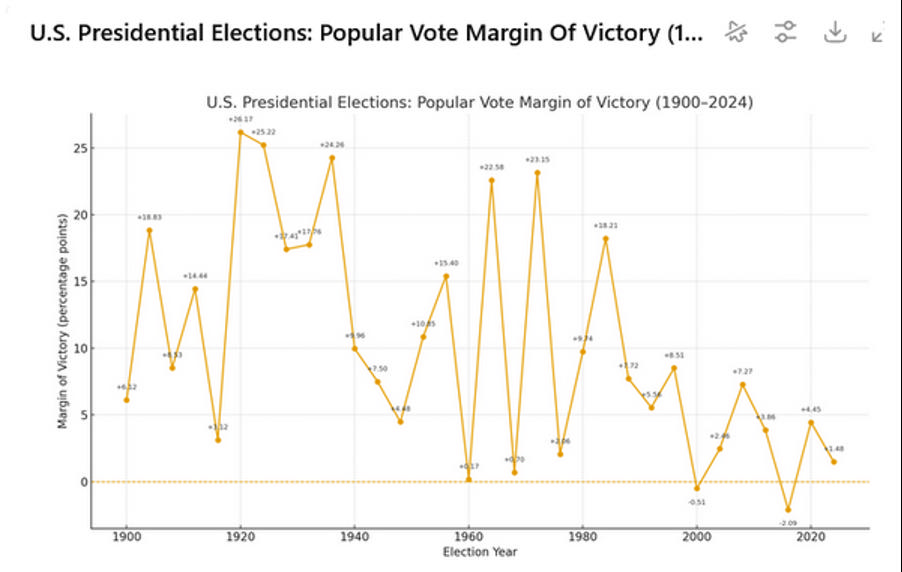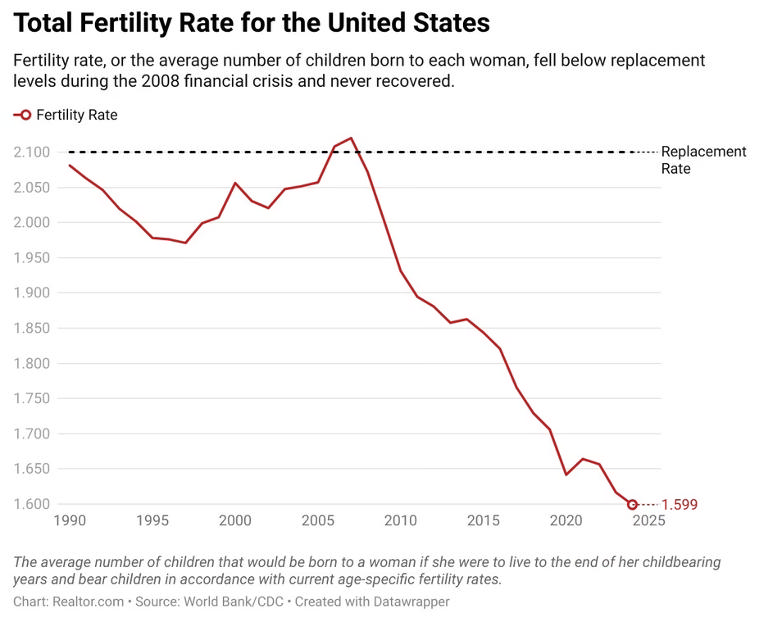Is There a Solution to a Divided Government?
The US Government shutdown illustrates the fact that we live in an era when about half the country disagrees with the other half so the art of debate and persuasion is a necessary talent for success.

Deepening Divisions Within a Single Party
This Washington Post article illustrates the vast differences this country faces even within a single party — the Republican Party. Kirk’s widow and POTUS disagree on how Christians should act, and that divide could replay 1992 and 1996, where Perot split the Republicans. Both Bush Sr. and Dole would have won if the Perot votes had gone to them. The 13-point swing that Kirk delivered in his 18/29 demographic was the 2-point margin that put Trump in the White House in 2025.
From 1900–1990 the average popular margin of victory was 12.8%; since 1990, it has been 3.4%. We are a 50/50 country, so more than ever, the art of persuasion is exponentially more important than a few decades ago.
A Culture Saturated in Conflict
We have serious problems. If you look daily at Reuters, CNN, WSJ, AXIOS, BBC America, Fox, and others, the majority of news is about conflict — not just world conflict but mainly conflict within our government. None of it is Good News.

Lessons From Reagan and O’Neill
Tip O’Neill and Reagan disagreed on almost everything. They fought over almost everything from Social Security to increased defense spending and Reagan's hardline stance against the Soviet Union, fearing it would escalate the Cold War. Despite their public sparring, both men avoided personal attacks, and their staff noted that heated policy arguments never became personal feuds. Each saw the other as a patriot doing what he believed was right.
They understood that compromise was essential in a divided government. Despite different ideologies, both valued public service; the rights of citizens and the obligation of the government under the Constitution were more important than getting their own way.
When Reagan was shot in 1981, O’Neill visited him in the hospital, held his hand, and prayed with him.
Reagan had the only popular vote margin above 8% in the last 50 years (almost 20%), and he could have crushed O’Neill with that mandate, but he was a long-term thinker and a person who valued the country over his own ego. Together, because they valued the Constitution, they rescued Social Security through bipartisan negotiation, simplified the tax code and reduced loopholes with support by both parties, and they still managed to pass essential budgets through give-and-take.
Do We Still Have Statesmen?
Do we have very few statesmen today, or are they mainly politicians who value personal victories more than national victories? Does the country need the people that the American Association of Christian Schools (AACS) produces through its leadership programs — who can learn to see the value of another’s position and who can persuasively debate for the good of the nation to achieve victories for all the people?
Rising Extremes and the Shrinking Middle
Today Libby Emmons of the Post Millennial wrote “The far-left, well-funded activist contingent is seeking to remove Schumer, AOC is already hinting at a 2028 Senate run. Schumer's days in the Senate are numbered. But it's not just the man whose time is up, it's the establishment, centrist (such as it is) wing of the Democrat Party who are being replaced, quickly and forcefully, with socialists. I remember distinctly a political climate where the right and left both wanted the same things for the country but disagreed on how to get there. But now, I don't think the political right and left want the same things at all, I think they want the opposite.” When Joe Manchin left the Democratic party, what did he see that has become so evident in the last few years?
In Dead Center: In Defense of Common Sense by former WV Senator Joe Manchin, he argues that both major parties in Washington have moved toward extremes, making governance harder and the middle much smaller. He frames his own approach as resisting that drift.
Government Dysfunction: Who Really Wins?
Who wins when the government shuts down, furloughing 700,000 government workers at a cost of $2.5 billion per week, when 42 million don’t have food benefits, when 5,000 flights per day are canceled, when 4 million people lose health insurance and another 22 million will soon not be able to afford it?
Maybe the furloughed workers will be paid the $12 billion it cost, but did the citizens they work for get anything for it, or is it just wasted? Some worked and are waiting to get paid, and some did not show up.
If we cannot sit together and work out what is best for the citizens, then how are we going to solve the problems that grow bigger each day?

Social Security: A Crisis of Demographics
Social Security has a major problem if we do not follow the Reagan–O’Neill model. In 2022, roughly speaking, the “flow” of new beneficiaries (~5.6 million) dwarfs the flow of new births (in the U.S., births ~3.6 million in 2022). In effect, the aging and mortality/benefit side dominates the demographic pressures, whereas fertility is relatively weak supply side in balancing that. (For comparison: the number of U.S. births in 2022 was ~3,664,292 per NCHS).
Total fertility rate — the average number of children born to each woman — was approximately 2.08 in 1990, but down to 1.64 in 2020 and 1.59 in 2025 according to CDC data. A fertility rate of at least 2.1 is considered the replacement rate, or the rate at which each generation has enough children to maintain a steady population in the future.
Their question on many people’s minds is: “Will Social Security be around when I am old enough to get it?” Look at the numbers: as the population that pays for it goes down and the numbers of retirees who receive it goes up, where does that leave Social Security?
Housing, Education, and Fertility
Their next two questions are about housing and education and how they relate to the fertility rate.
The price of a single-family starter home has gone up in the last 20 years at double the inflation rate, and the only thing more daunting than that is the average cost of a college education, which is 3× inflation. Is a lower birth rate caused by the high cost of housing? Data seems to say it is.
Rising housing costs were responsible for 51% of the total U.S. fertility rate decline between the 2000s and 2010s, according to new preprint research by Benjamin K. Couillard, a doctoral candidate in economics at the University of Toronto.
Couillard's study found that if housing costs had remained flat after 1990, there would have been 13 million more children born in the U.S. by 2020. The country's total fertility rate in the 2010s would have been 77% closer to the replacement rate if those costs hadn’t increased, the research showed.
“That’s a surprising result,” says Couillard. “It suggests that housing costs are a major driver of fertility decline. Housing abundance is not just about affordability; it’s about long-term demographic sustainability.”
Realtor.com® senior economist Jake Krimmel reviewed Couillard's study and calls it “one of those rare findings that's intuitive, important, and has actionable implications for policy.”
Lessons From Japan and the Impending U.S. Education Cliff
Japan is a model of a country that has sustained a declining birth rate that has remained for the last 50 years below the 2.1 TFR needed to maintain a steady population. The TFR for Japan is at 1.2 today. This has resulted in rising living costs and a punishing work culture that makes family formation increasingly difficult. As a result, younger generations are delaying or forgoing marriage and parenthood altogether.
It also means school closures. In the last 23 years almost 9,000 schools (15%) have permanently closed in Japan.
That same U.S. birth rate challenge — 1.59 per female today vs. 3.7 per female in 1960 and a little less than 2.1 in 1990 — has also caused an education cliff, meaning that in 25 years we will be educating 40% fewer K-12 students in the U.S. than we educated 30 years ago; a drop from 60 million to 38 million.
In WV, it costs $19,500 per public school student today, up from $15,500 in the last 3 years.
What about college? If Marshall can enact a program where every person who graduates leaves with no debt and a job offer, why can't every other school?
National Vulnerability and the Urgency of Economic Stability
There is an old movie line where the Chinese ambassador is speaking to the U.S. Secretary of State and states, “We don't need to attack you; we will just let you keep doing what you are doing and then we will repossess you when you bankrupt yourselves.” Could that be their strategy?
Is it really like Clinton said — It IS the economy, stupid?
The Need for Persuasive, Constructive Leadership
If there was ever a time that students needed to learn the art of constructive persuasion, it's now — because tomorrow’s leaders are today’s students.
Maybe AACS should hold a class for Congress instead of just for high school students.
What do you think? Please click this link and take the survey

HGN Staff
His Good News magazine seeks to unite and empower parents, educators, legislators, and voters in West Virginia to support and advance Christian education, religious freedom, and conservative values. By fostering a strong Jesus-based foundation within our communities, we can influence legislation, protect religious freedoms, and ensure that our children receive a quality Christian education.
















